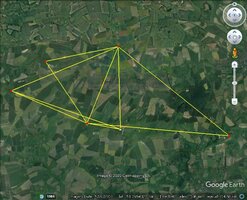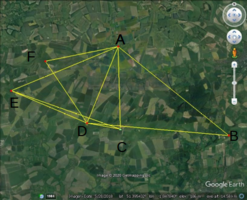A computer programme was written some years ago indicating that the probability of an isosceles triangle between three random points (+/- 0.5% of the leg lengths) is about 3%.
I would like to see the details of that calculation; it presumably makes some additional assumptions.
The probability you ask for, even after some clarifications, is probably too hard to work out in general, but could conceivably be done by computer
given the locations of the five known points.
There are a total of 10 possible triangles that could be formed with the new point A, so your claim is that half of the triangles formed are isosceles, with random location of apex as well. So there are something like 30 possible places to put your five isosceles triangles, increasing the probability considerably from what you might expect. One could conceivably mark regions where A could be located to make each of these 30 potential triangles isosceles, and then identify regions where at least five of these intersect. Find their areas, and you have the answer (if you have identified a region in which A is supposed to be randomly chosen).
I believe the probability of the Obelisk being located at random will be a low number and if so this will support the late Professor Thom’s assertion that the Neolithic people were surveying the landscape with skills akin to his own.
But such a probability doesn't really tell you anything; assigning meaning to such an after-the-fact probability calculation is very tricky. See
here. If the probability of five isosceles triangles is low, that doesn't imply that the probability that the location was chosen randomly is low. And how do we know that the five high points you chose are the only relevant ones?
My main question is not mathematical. It is this:
Why would they want to make randomly oriented isosceles triangles; and
how in the world, if you wanted to accomplish this even today, would you accomplish this? That would amount to finding one of the regions I mentioned as part of finding the probability; I'm not sure a modern surveyor would take on the challenge.
I'd be much more likely to want to help support your theory if I could imagine a motivation for all the work it would take neolithic people to figure this out.



